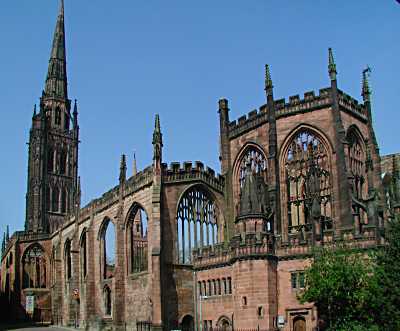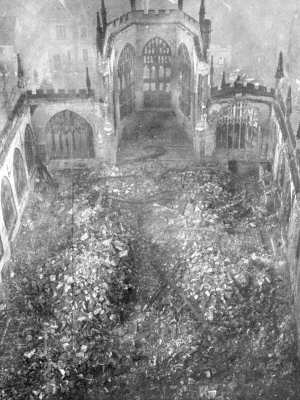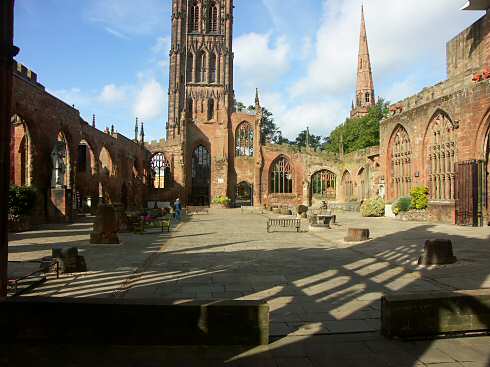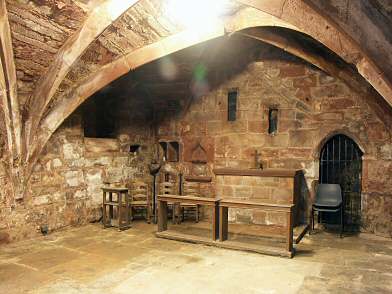|
Index...
|

 ere are a few photographs taken around the old cathedral which is now in ruins since the infamous nine-hour Blitz of 1940.
ere are a few photographs taken around the old cathedral which is now in ruins since the infamous nine-hour Blitz of 1940.
For many centuries the structure had looked much the same as in the 1900 photo above, but on the evening of Thursday 14th November 1940 everything changed. At around 7:10pm the air-raid siren sounded just as it had done on many occasions that year. Little did the people of Coventry suspect that this was about to become the most prolonged and devastating attack on any city in the history of warfare to date.
Approximately half an hour after the raid began, the first of many incendiary bombs landed on the roof of the cathedral. Provost Dick Howard and a small team of brave helpers, including the elderly 'Jock' Forbes - the Stone Mason, plus two younger men, fought hard to extinguish the many fires around the roof and inside the building. The four men spent the evening dashing around the cathedral roofs, attempting to rip open the lead with axes so that water could be poured onto the fires. The problem was exacerbated by the roof's construction - the inner wooden vaulted ceiling being separated from the wood and lead sheeting outer roof by an eighteen inch gap, inside which many incediaries rested and blazed away, out of easy reach by the fire fighters.

As the number of incendiaries landing on the old roof increased, the fires became harder to tackle by the small team. Even when the Solihull Fire Brigade made it through to the cathedral a while later, the hoses soon became damaged, and water supplies dried up. With water mains around the city getting fractured there was little hope of fighting back the flames. By around 11pm, all the St. Michael's fire fighters could do was remove as many items of value as they could from the blazing building, and retire to safety, leaving the uncontrollable flames to consume the once great structure.
The next morning, all that remained was a shell full of rubble, and of course, the tower and spire. Provost Howard noted later that he still noticed a sense of beauty in the fallen masonry, as though the actual piles of rubble posessed something living.
This surreal, yet strangely beautiful photo appeared in the next day's newspaper. Life can produce huge coincidences from time to time, but none could be as spiritually ironic as this image. As can be seen in the centre of all that still smoking rubble of our Old Cathedral, two of the huge steel strengthening straps have fallen into the shape of a cross.

To many people, myself included, it must have seemed a mystery why the fire consumed not only the combustible materials but also caused the great pillars to fall. The reason lies in the steel strengthening girders that were attached to the roof beams around 1890 to reinforce the structure. The intense heat from the flames caused these to distort and as they did so, they tugged at the masonry until the pillars and clerestory walls fell inwards and crashed to the ground.
For the remainder of the war, Provost Howard continued to provide services to the brave people of Coventry in the Wyley Crypt Chapel beneath the Nave of the cathedral.

This "undercroft" (pictured in 2005 on the right) was entered from St. Michael's Avenue, but there was no service for the very first Sunday after the blitz - for an unexploded bomb was discovered in the Avenue, near the entrance!
This chapel proved too small for a proper congregation, and Howard was very grateful to Canon Graham Clitheroe, who allowed him to share sermons in Holy Trinity Church until the end of 1945. Just one more small example of the spirit shown in Coventry during such difficult times.
More can be read about the bombing of Coventry in November 1940 in the Coventry's Blitz section.
Reassuringly, these kind of terrible events often inspire people to create something special. One such creation was a beautiful poem by Neville Macaulife of California, which I am honoured to be able to present here.
Please click on the rose to view the poem...

Website by Rob Orland © 2002 to 2026